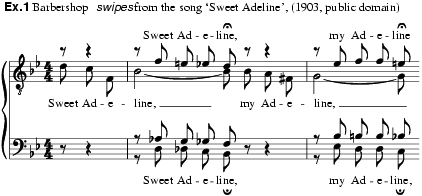
A style of unaccompanied singing that originated in the USA in the late 19th century. It is characterized by four-part harmony using chords that contain tritones. Dominant and diminished 7th chords, as well as half-diminished 7th and augmented 6th chords, are used, but major 7ths, flattened 9ths and chords of the 13th are considered stylistically inappropriate, as are non-chord notes. The melody is carried by the ‘lead’ (second) tenor, while the first tenor harmonizes above; the bass provides the foundation, and the baritone completes the harmony, frequently crossing above the melody. Chord progressions known as ‘swipes’ often compensate for the lack of instrumental accompaniment (ex.1).

The barbershop quartet movement, which flourished between about 1895 and 1930, was given impetus by the fledgling recording industry. Performances by such professional groups as the Manhansett, Haydn, American and Peerless quartets became widely available and gave rise to the formation of thousands of amateur groups throughout the country during the movement’s peak years (1910–25). A fundamental change in the American popular song also contributed to the development of barbershop harmony. Many tunes in the earlier decades of the 19th century were constructed around the tonic octave of the scale, but by about 1895 melodies with a dominant-to-dominant range had evolved. This meant that the bass part was less likely to double low melody notes, and it also allowed the upper tenor part to flow in a smooth line above the lead, mostly in 3rds and 6ths. The words of barbershop songs speak of commonplace ideas: home, spouse, children, love (both joyful and sad) and fond memories of earlier times. Interpretative liberties are taken in performance using rubato, and extended song endings known as tags are also used.
By the late 1920s and early 1930s the increasing popularity of jazz, sound films, records, cars and radio had led to a decline in the number of active quartets. In 1938, however, the Society for the Preservation and Encouragement of Barber Shop Quartet Singing in America was founded. By the end of the 20th century there were affiliated clubs with quartets and choruses in Britain, Scandinavia, Europe, Australia, New Zealand and South Africa. Two organizations for women barbershop singers, Harmony Incorporated and Sweet Adelines, were also formed, both with affiliated societies overseas. From the 1940s on, barbershop harmony was sung either by male or by female quartets and choruses, but in the later 20th century mixed-voice groups gained increasing popularity.
J.W. Johnson: ‘The Origin of the “Barber Chord”’, The Mentor, xvii/1 (1929), 53
S. Spaeth: Barbershop Ballads (Englewood Cliffs, NJ, 1940)
D.K. Antrim: ‘The Barbershop Brotherhood’, The Etude, lxxii/11 (1954), 11
D. Martin: ‘Three Eras of Barbershop Harmony’, The Harmonizer, xv/2 (1955), 20
J.L. McClelland: Of, By, and For the People: a History of Barbershop Harmony (thesis, College of Wooster, PA, 1959)
D. Martin: ‘The Evolution of Barbershop Harmony’, Music Journal Annual (1965), 40
V. Hicks, ed.: Heritage of Harmony (Kenosha, WI, 1988)
V. HICKS